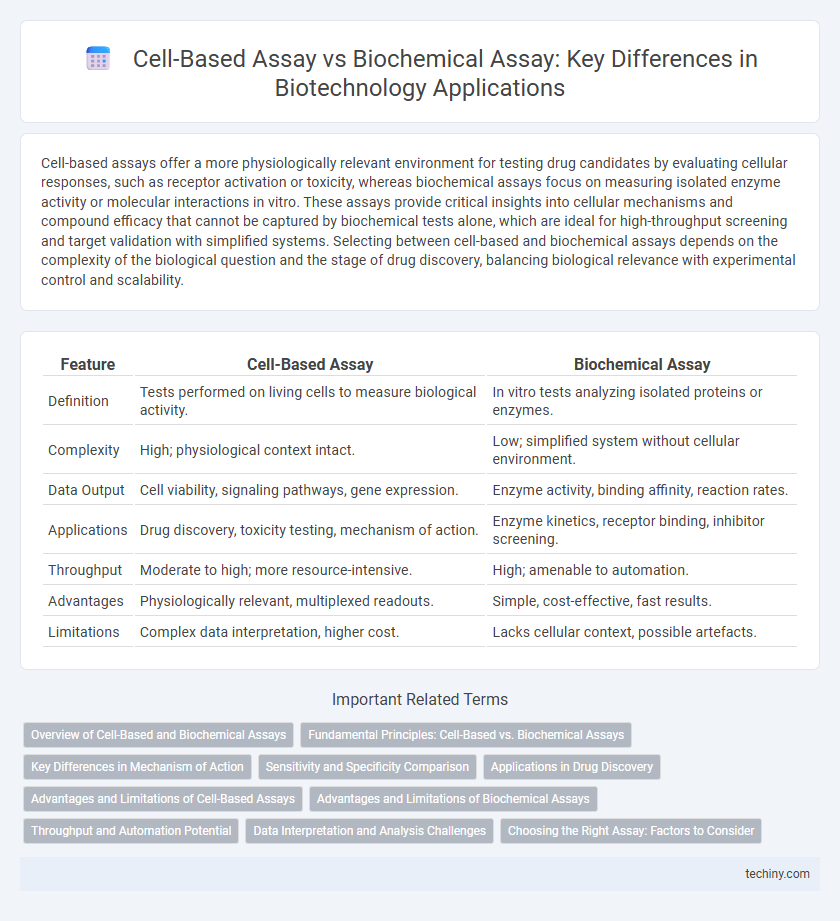Cell-based assays offer a more physiologically relevant environment for testing drug candidates by evaluating cellular responses, such as receptor activation or toxicity, whereas biochemical assays focus on measuring isolated enzyme activity or molecular interactions in vitro. These assays provide critical insights into cellular mechanisms and compound efficacy that cannot be captured by biochemical tests alone, which are ideal for high-throughput screening and target validation with simplified systems. Selecting between cell-based and biochemical assays depends on the complexity of the biological question and the stage of drug discovery, balancing biological relevance with experimental control and scalability.
Table of Comparison
| Feature | Cell-Based Assay | Biochemical Assay |
|---|---|---|
| Definition | Tests performed on living cells to measure biological activity. | In vitro tests analyzing isolated proteins or enzymes. |
| Complexity | High; physiological context intact. | Low; simplified system without cellular environment. |
| Data Output | Cell viability, signaling pathways, gene expression. | Enzyme activity, binding affinity, reaction rates. |
| Applications | Drug discovery, toxicity testing, mechanism of action. | Enzyme kinetics, receptor binding, inhibitor screening. |
| Throughput | Moderate to high; more resource-intensive. | High; amenable to automation. |
| Advantages | Physiologically relevant, multiplexed readouts. | Simple, cost-effective, fast results. |
| Limitations | Complex data interpretation, higher cost. | Lacks cellular context, possible artefacts. |
Overview of Cell-Based and Biochemical Assays
Cell-based assays measure the biological activity of compounds within living cells, providing insights into cellular mechanisms and drug effects on cell viability, signaling, and metabolism. Biochemical assays analyze isolated proteins or enzymes in vitro to quantify biochemical interactions, enzymatic activity, and binding affinity under controlled conditions. Both assay types are critical for drug discovery, with cell-based assays offering physiological relevance and biochemical assays enabling precise mechanistic studies.
Fundamental Principles: Cell-Based vs. Biochemical Assays
Cell-based assays measure biological activity within living cells, capturing complex cellular processes such as signal transduction, gene expression, and cytotoxicity, which provides a physiological context often missing in biochemical assays. Biochemical assays isolate specific molecular interactions, such as enzyme activity or receptor binding, offering high specificity and ease of quantification without cellular complexity. Understanding these fundamental differences allows researchers to select assays that balance physiological relevance and experimental control in drug discovery and molecular biology studies.
Key Differences in Mechanism of Action
Cell-based assays measure biological responses in living cells, capturing complex cellular processes such as receptor-ligand interactions, signal transduction, and cellular metabolism. Biochemical assays focus on isolated molecular targets, quantifying enzyme activity, binding affinity, or protein interactions in a controlled environment devoid of cellular context. The key difference lies in cell-based assays providing physiological relevance through intact cellular systems, while biochemical assays offer specificity by examining individual biomolecules.
Sensitivity and Specificity Comparison
Cell-based assays provide higher physiological relevance, offering increased specificity by measuring functional responses within living cells, while biochemical assays excel in sensitivity by detecting direct molecular interactions or enzyme activities with minimal background noise. The complex cellular environment in cell-based assays can sometimes reduce sensitivity due to signal variability, yet enhances specificity through pathway-contextual information. Biochemical assays, though less specific to in vivo conditions, allow precise quantification of target binding and activity, making them highly sensitive in controlled, simplified systems.
Applications in Drug Discovery
Cell-based assays enable evaluation of compound effects within a biological context, measuring cellular responses such as signaling pathways, toxicity, and phenotypic changes. Biochemical assays focus on isolated target interactions, providing precise data on enzyme activity, receptor binding, or protein-protein interactions critical for lead identification. Integrating both assay types accelerates drug discovery by combining mechanistic insights with functional relevance in physiological environments.
Advantages and Limitations of Cell-Based Assays
Cell-based assays offer the advantage of measuring cellular responses in a physiologically relevant environment, capturing complex interactions such as receptor signaling, metabolic changes, and cytotoxicity. These assays enable the evaluation of compound effects on cell viability, phenotype, and function, providing insights that biochemical assays, which isolate specific molecular targets, cannot fully replicate. However, cell-based assays often have limitations including higher variability, longer assay times, and increased complexity in data interpretation compared to the more straightforward, high-throughput biochemical assays.
Advantages and Limitations of Biochemical Assays
Biochemical assays offer high specificity and sensitivity by directly measuring enzyme activity, receptor binding, or protein interactions, making them ideal for identifying molecular mechanisms at a biochemical level. Their limitations include a lack of cellular context, which can lead to false positives or negatives due to absence of cellular metabolism, membrane permeability, and post-translational modifications. While biochemical assays provide rapid, scalable, and cost-effective screening options, they may not fully predict compound efficacy or toxicity in vivo.
Throughput and Automation Potential
Cell-based assays offer moderate to high throughput capabilities with significant automation potential due to their compatibility with robotic liquid handling systems and high-content imaging platforms. Biochemical assays generally provide higher throughput and greater ease of automation, as they rely on simpler reagent-based reactions that are easily miniaturized and integrated into automated screening pipelines. The choice between cell-based and biochemical assays depends on the balance between throughput demands and the need for physiological relevance in drug discovery workflows.
Data Interpretation and Analysis Challenges
Cell-based assays provide complex biological context but introduce variability due to cellular heterogeneity, complicating data interpretation with factors like cell viability and intracellular signaling. Biochemical assays offer precise measurements of molecular interactions but may overlook cellular complexity, leading to challenges in correlating in vitro results with physiological relevance. Both assay types require advanced statistical methods and bioinformatics tools to accurately analyze high-dimensional data and extract meaningful insights.
Choosing the Right Assay: Factors to Consider
Selecting the appropriate assay in biotechnology depends on the specific biological context and research objectives. Cell-based assays provide insights into cellular responses and complex signaling pathways, while biochemical assays offer precise quantification of enzyme activities or molecular interactions. Key factors include assay sensitivity, biological relevance, throughput requirements, and the type of data needed for interpreting cellular mechanisms or drug efficacy.
cell-based assay vs biochemical assay Infographic

 techiny.com
techiny.com